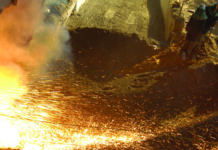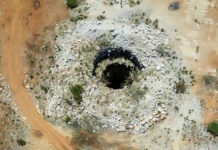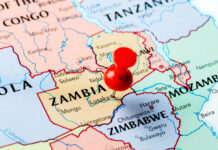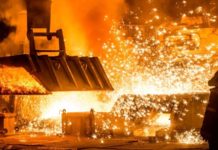[miningmx.com] — ANGLO American’s decision to meaningfully reduce its 51% stake in AngloGold Ashanti – and to buy back its own shares with the proceeds – was put into action last month. It’s a good decision. The world’s investors accepted that action positively and the prices of both shares remained strong.
It was especially pleasing to see that demand for AngloGold shares remained high despite a potential high supply. AngloGold also decided on a rights issue of its shares, alongside the offer of Anglo’s stake. That further increases the supply of shares.
In last year’s announcement of the proposed sale of its stake in AngloGold, Anglo added that the two companies (or their shares) are valued completely differently by the market. The graph shows that these valuations sharply moved away from each other. AngloGold’s price:earnings ratio has risen uniformly to the nearly unheard of level of more than 100, while that of Anglo has remained stable at approximately 15.
Recently, AngloGold even began to show a loss and its p:e became negative. Miningmx’s viewpoint is that such a calculation doesn’t have any investment or mathematical purpose and we cut the graph off at a date before the p:e ratio began showing as a negative.
The economic merits and the positive effect of Anglo’s decision to sell AngloGold and to buy back its own shares is illustrated in the creation of a small business model on the grounds of the predicted profit that each company could achieve in 2006.

According to Thomsons First Call, the biggest company that collects the opinions of investment analysts internationally, AngloGold could achieve a profit of R11.15/ share this year. AngloGold recently traded at R322/share. That gives the share a one-year ahead earnings yield of 3.5%.
Thomsons indicates that Anglo American could achieve a profit of R19/share for 2006. Anglo itself currently trades at R234/share, which places it at a future earnings yield of 8.1%.
In short, Anglo is selling an asset for which the expected profit for the coming year is only 3.5% and is buying, with the proceeds, an asset for which the profit could be 8.1%. That’s simply good asset management and provides a higher profit for the company and its shareholders.
For the same reason, Anglo has already indicated that it also wants to sell its 70% share in Highveld Steel and that Mondi, currently a wholly owned subsidiary, may be listed separately. Anglo also asked Tongaat, another of its major investments, that it should do something to unlock value for shareholders.
The focus that Anglo places on the profits of assets is reminiscent of the successful application of the model of Economic Value Added (EVA), which was developed some time ago by Stern Stewart & Co. The model was applied successfully, especially in the Eighties, to place Coca-Cola on a winning streak again.
EVA recommends that a company should calculate a so-called opportunity cost for all applied capital and frequently test all its business against it. Sometimes, when a company has too much cash, it easily forgets that its own capital also has a cost and also needs to earn a profit. In fact, we’re all inclined to forget that very quickly. It’s a good idea for a company to accept an opportunity cost of 12%/year for all its capital and then test its performance against that.
However, few companies do so, especially when it comes to buying back its own shares. Companies are inclined to use only the after-tax profit that can be earned on the money market as the costs of their capital. It’s possible to prove that it’s shrewder to invest that capital by buying back your own shares.
In South Africa, the after-tax profit on surplus cash for companies is currently less than 5% and it’s therefore apparently profitable for companies to buy back their own shares to an earnings yield (EY) of as low as 5%. The opposite of that is an EY of 20, which is meaningfully more than the 12 or 15 at which South Africa’s leading companies’ shares now trade.

That seemingly low after-tax profit on surplus capital – of which South African companies have a lot but of which US companies have much more – has already resulted in record buying back of shares in the US last year.
According to Standard & Poor’s, the 500 top US companies included in its S&P 500 index bought back shares worth $349bn last year. That was an increase of 77% above the previous year. The graph (created by S&P) shows how the buyback of shares by those 500 top companies exploded, especially since 2004.
Similar statistics for South Africa aren’t readily available, but we shall conduct research on the subject, together with the JSE. Last year financial services company, Sanlam, after the sale of its major stake in Absa, a bank, also used a large part of the proceeds for a specific share buyback. With Anglo kicking the year off with a planned buyback of $2bn (approximately R12.5bn) worth of shares, a new record will probably be set this year.
Howard Silverblatt, an analyst at S&P, points out a few disconcerting characteristics of the latest wave of buying back shares by S&P 500 companies. It has ostensibly become the preferred method – rather than dividends – of companies to pay out surplus cash to shareholders.
Silverblatt draws attention to the fact that dividend payouts by S&P 500 companies increased by merely 11.5% and that companies now spend 73% a year more on buying back shares than on what’s paid out in dividends.
 Buybacks expose a woeful lack of CEO imagination
Buybacks expose a woeful lack of CEO imagination
The buyback of shares is a passive form of investment and doesn’t create new capacity. In fourth quarter 2005 the S&P 500 companies used 61% of their profit to buy shares back and paid out 32% as dividends. Together, that represents 93% of their earnings. Jointly, those companies thus invested a measly amount of their profits in the cap of new capacity.
On Bloomberg, Paul Davy was very critical concerning the practice in a report headlined “Buybacks expose a woeful lack of CEO imagination” and especially so of the responsibility of directors with regard to the fact that buybacks put money back in the pockets of shareholders.
According to directors, it causes the share price to rise on the one hand and on the other hand increases the profit per share of the company.
But it’s not that easy, writes Davy. He says that Exxon Mobil has been buying back large quantities of its shares yearly since 2000. In 2005 alone it bought back shares worth $18bn – the same amount the company spent in the same year on new refineries and exploration.
Despite the large-scale buyback of shares over the past five years, Exxon Mobil’s earnings per share is currently only 4.1% more than it would have been without it.
Davy calls attention to the fact that Dell, the world’s largest manufacturer of computers, spent 20% of its profits last year to buy back some of its shares but that the company has never declared a dividend. Davy wonders if it might not be better if Dell declared a dividend and gave shareholders the opportunity to decide for themselves where and how they’d like to invest the company’s surplus cash.
That raises the question of whether it isn’t very paternalistic of companies to buy back shares rather than declare a dividend and thus leave the decision of reinvestment up to shareholders.











